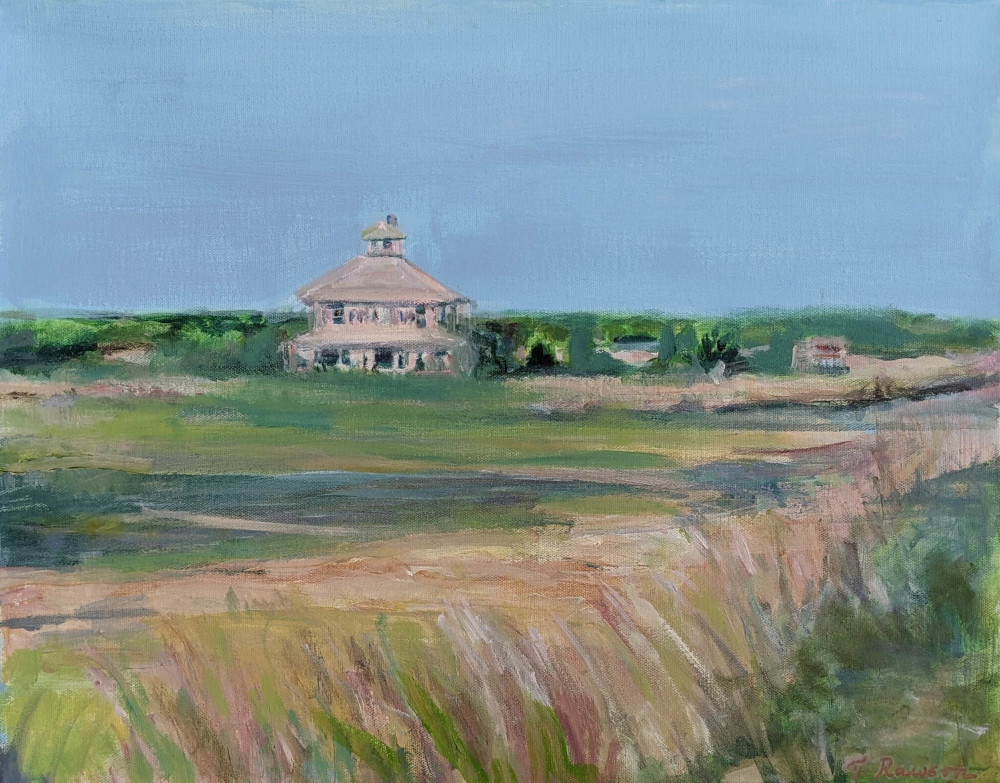At first glance, it’s just an old, dilapidated house sitting in the middle of nowhere. Its pink paint peeling after a century of battling the wind, rain, and sun, the battered house with the empty windows squats on the road as cars pass by on their way to Plum Island.
It’s easy to overlook.
But come in early evening as the setting sun illuminates the empty windows. Marvel at the glowing sky that mirrors the pinkness of the paint. The remoteness of this domestic structure in a wild place becomes a metaphor for sturdy New England resilience in the face of harsh elements.
The quiet solidness of the Pink House in Newbury has made it a subject of countless works of art, and its century-long presence has made it a welcome mat for those visiting Newburyport and Plum Island.
But, the days of the Pink House may be numbered. In March, the U.S. Fish and Wildlife Service announced the house, built in 1925, will be removed from its site at the Parker River Wildlife Refuge, with its land restored to wildlife habitat. Keeping the house intact would strain the refuge’s limited resources, according to the service. The property floods routinely, and with sea levels projected to rise, that will only increase in future. Additionally, the site contains asbestos and other materials deemed to be harmful to human health.

For the past eight years, the service says, it has worked with local elected officials and advocacy groups to find a plot of land to swap for the house land. But, because the habitat is of high value to the refuge, only an equal-value land exchange valued at about $450,000 would be acceptable. In their final environmental assessment, Fish and Wildlife stated there had been an exhaustive search for land to exchange, but no viable parcel was located.
Rochelle Joseph, president of Support the Pink House, remains optimistic that as long as the house is still standing, there is hope it will be saved. “We’ve always worked for a win for all,” Joseph says. “We love the refuge. It’s just the right thing to do.”
What is so special about the Pink House? First, there’s the colorful legend. The story about a “spite house” built by a divorced man to get the final revenge against his ex-wife by building her a house in an isolated salt marsh gives it a certain mystique, according to Sandy Tilton, photographer and a member of Support the Pink House.
“It’s been passed down from generation to generation,” she says. “It’s a mystery that grabbed the imagination of the people.”
While the legend may or may not be true, original owners Harry and Ruth Cutter did divorce after an unhappy marriage. The house was privately owned until 2011, when it was purchased by the U.S. Fish and Wildlife Service/Parker River National Wildlife Refuge.

For generations of residents and visitors to Plum Island, the house’s presence has been a marker that the journey is almost over, and vacation has begun.
Artist Kelly Page says, “People say ‘Plum Island won’t be the same if it isn’t welcoming me when I go by. It’s a sense of security, of consistency, and for families it means summer is coming, and that becomes part of the memory.’”
Nancy Gardella, executive director of the North of Boston Convention and Visitors Bureau, agrees. “It is part of the beloved landscape of the region that people look forward to when they return year after year. There is tremendous value in that,” she says. “When we see it, we feel happy. It brings out every happy memory from our childhood.”
For the artists, domesticity juxtaposed against wildness makes the house an appealing subject.
“Because it is an anomaly on the landscape, it has become a source of creative energy for those who see it,” says Bronson de Stadler, a member of the Newburyport Preservation Trust board. “Seeing its very striking and unorthodox presence against the vast empty marshes with woodlands in the distance and the sea seconds away inspires us. It makes us wonder about our presence in the order of nature.”
Tina Rawson, a visual artist and teacher, has made the house, which she calls wobbly and wonky, the subject of dozens of paintings.
“There is something about the shape of it, how it sits in the landscape, it has a personality,” she says. “I feel like it is an old-time farmer’s wife or a washerwoman—practical, solid—and it feels like a grandmotherly presence.”

Rawson is not the only one who feels a feminine presence in the house. De Stadler imagines it as the work of a 1970s-era “counterculture grandmother who decided to paint the house to her liking and said, ‘The hell with what people think.’”
“She could also have been an artist who wanted to make a statement, to bring color to the often-dreary New England landscape,” he says.
Artist Cathy Grassello sees a symbol of New England toughness and beauty in the face of harsh elements. “It’s been there almost 100 years, and it probably shouldn’t be. It’s survived king tides and snowstorms and all kinds of things, and it is still there,” she says.
Should the house be demolished, Grassello says, its loss will be felt.
“Newbury will lose a part of its culture,” she says. “Maybe this isn’t the most historic or valuable or beautiful house ever built, but it is a part of Newbury’s soul and also a huge inspiration for people. That welcome sign will be gone.”
For more information about efforts to save the Pink House, visit supportthepinkhouse.com

